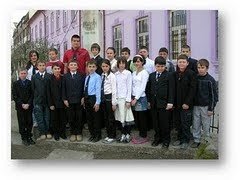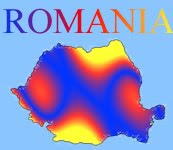There are a lot of wonderful and interesting places worth to be visited, in all the regions of Romania, but we present only a few of them.
1. The Palace of the Parliament
1. The Palace of the Parliament

(called The People”s House)
in Bucharest, is a multi-purpose building containing both chambers of the Romanian Parliament. According to the Guinness Book of World Records, the Palace is the world's largest civilian administrative building, most expensive administrative building, and heaviest building.
 2. The Painted Churches from northern Moldavia are unique in Europe for their painted exterior walls, decorated with 15th- and 16th-century frescoes with religious scenes.They are seven Romanian Orthodox churches in Suceava County, Romania, built approximately between 1487 and 1532. The unique colour of the paintings is still a mistery for the specialists, for example the blue of the Voroneţ, became „Voroneţ blue”.
2. The Painted Churches from northern Moldavia are unique in Europe for their painted exterior walls, decorated with 15th- and 16th-century frescoes with religious scenes.They are seven Romanian Orthodox churches in Suceava County, Romania, built approximately between 1487 and 1532. The unique colour of the paintings is still a mistery for the specialists, for example the blue of the Voroneţ, became „Voroneţ blue”.Since 1993 they have been listed by UNESCO as a World Heritage Site.
4. Bârsana wooden church from Maramureş is one of the highest in Europe (57m). It is in the eight churches from Maramures included in UNESCO World Heritage List since 1999, because they are an exceptional expression of the cultural heritage of this mountainous area of northern Romania.
5. CASTLES
Bran Castle, nicknamed “Dracula’s Castle”(even if Vlad Ţepeş never lived there) is 30 km far from Braşov. It used to be the royal residence of Queen Marie of Romania.
A historical monument and a museum now, Peleş Castle placed in Sinaia, Prahova county was destined to be the royal place for hunting and summer holidays.
The Hunyad castle from Hunedoara, Transylvania is a relic of the Hunyadi dynasty from the 14th century. It was built mainly in Gothic style, but has Renaissance architectural elements, too. Some significant parts of the building are: the last defense tower (called "Ne boisa" which means "Do not be afraid" in serbian language), the Capistrano Tower (named after the Franciscan monk from the castle court), the Knights' Hall (a great reception hall), the Club Tower, the White bastion, which served as a food storage room, and the Diet Hall.
6. LANDSCAPES
The Bicaz Canyon (The Keys of Bicaz) is one of the most spectacular places in Romania, located in the north-east part of the country. The canyon was dug by the waters of Bicaz River. The road links the Red Lake and the Bicaz locality and is 6 km long.
Babele (The Old Women) and The Sphinx are natural monuments from the Bucegi Mountains - the result of erosion of the rock layers.
Babele - the two natural formations are surrounded by legends that talk about transforming Dochia (the old lady) into the sheepfold stone.

The Sphinx is an attractive human form which nature has carved over time. Well positioned, with a rough look, it gives the impression that oversees those lands.
The Black Sea - Romanian seaside resorts, a chain of string from north to south over a distance of about 82 km show a variety of natural attractions, offering opportunities to make helio cure, medical spa treatment, practice water sports and recreation. The beach is renowed for its fine sand, high quality. The biggest resort, with the beach length of 10 km is Mamaia. Some other beautiful resorts are: Constanţa, Eforie Nord, Eforie Sud, Costinesti, Mangalia,Jupiter, Olimp, etc.
The Danube Delta is the second largest river delta in Europe, after the Volga Delta, and is the best preserved on the continent. It lies in the south-east of Romania in Tulcea county.
Scărişoara cave is one of the biggest ice caves in the Apuseni Mountains of Romania, at an altitude of 1165 metres above sea level.












